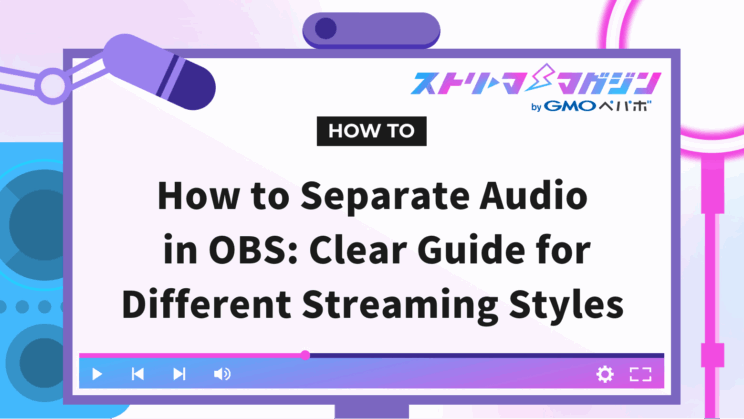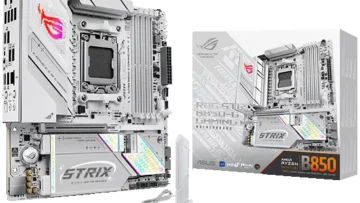How to Separate Audio in OBS: Clear Guide for Different Streaming Styles

Index
- Features of “Capture Audio” That Are Helpful When Separating Audio in OBS
- Preparations for Separating Audio in OBS
- How to Separate Audio in OBS by Streaming Style
- How to Create Multi-Tracks and Separate Audio in OBS
- Troubleshooting When Unable to Separate Audio in OBS
- Frequently Asked Questions About How to Separate Audio in OBS
Acquiring the skill to separate audio in OBS allows you to control game sounds, BGM, and microphone voices independently, which is extremely useful.
By utilizing the “Capture Audio” feature introduced in OBS Studio version 30.1 and later, you can separate audio without the need for installing plugins, streamlining the process with minimal effort.
This article explains how to separate audio in OBS tailored to different streaming styles. Enhance your audio management to elevate the quality of your streams and recordings.
Features of “Capture Audio” That Are Helpful When Separating Audio in OBS
The “Capture Audio” feature standard in OBS Studio is a new tool available from version 30.1 onwards.
Even if you know it helps separate audio, you might wonder exactly what benefits it offers.
Let’s delve into the characteristics of the “Capture Audio” feature first.
- Convenient without needing plugins
- Makes streams and recordings smoother
- Can avoid audio troubles
Convenient without Plugins
Previously, separating audio in OBS typically required dedicated plugins or external software. However, with the newly added “Capture Audio” feature, you can easily separate audio without plugins.
Specifically, you can manage audio as follows:
- Separate game sound and Discord audio during streaming
- Separate call and microphone audio
No need for additional software or complex settings, making it easy for those not familiar with OBS to try out.
If you want to include Discord audio in your OBS stream, this article walks you through how to capture and sync both audio and screen content:
How to Share Discord Audio and Screen in OBS – A Complete Setup Guide
Streams and Recordings Made Smooth
The allure of separating audio is that it simplifies audio management during streaming or after recording.
For instance, if you separately record game sound and mic sound during gameplay commentary, you can later perform edits like:
- Adjusting game sound volume
- Removing unnecessary noise
- Emphasizing sound effects
If you’re looking to stream or record gameplay with separated audio for commentary, this method is a perfect match.
If you want a more detailed look at screen recording with OBS, this beginner-friendly guide walks you through the setup and steps:
How to Record Your Screen with OBS Studio – Easy Setup & Step-by-Step Guide for Beginners
Avoid Audio Troubles
No one wants sudden notification sounds or unwanted private conversations accidentally captured during streaming or recording.
The “Capture Audio” function allows management by application, reducing the risk of audio troubles during broadcasts.
Many will find that separating game and call audio in OBS allows more stress-free broadcasting, which this feature can achieve by avoiding broadcasting mishaps.
Preparations for Separating Audio in OBS
To separate audio in OBS, first ensure your foundation is solid.
Before knowing how to separate audio in OBS, follow these preparation steps.
- Install OBS Studio Ver30.1 or later
- Mute or disable desktop audio
Install OBS Studio Ver30.1 or Later
To use the “Capture Audio” feature, you need OBS Studio version 30.1 or later. The version number appears in the top left corner when OBS is launched.
If the version is outdated, click “Help” ⇒ “Check for Updates” to update.
Mute or Disable Desktop Audio
Keeping desktop audio enabled during audio separation in OBS could lead to duplicated sounds, or unintended sounds in the game audio.
To prevent these issues, change desktop audio to mute or disabled.
The method to mute is as follows:
1. Find “Desktop Audio” in “Audio Mixer”.
2. Click the speaker icon of the corresponding item to mute it.
Muting allows you to easily revert it when needed.
Alternatively, the method to disable it is as follows:
1. Launch OBS, and click “Settings” at the bottom right.
2. Open the “Audio” tab.
3. Set “Desktop Audio” to “Disabled”.
How to Separate Audio in OBS by Streaming Style
Setting according to your streaming style simplifies audio management.
For instance, game streaming often requires separate recording of game and mic audio, while casual chatting streams need to exclude unrelated sounds.
Here, we introduce how to separate audio in OBS for two streaming styles:
- How game streamers can record audio separately
- How chat streamers can separate audio
How Game Streamers Can Record Audio Separately in OBS
Here’s how to separate audio for PC and TV game streaming.
PC Game Streaming Settings
In PC game streaming, using the “Game Capture” feature can individually manage game audio recording data.
1. Click the “+” button in “Sources” on the lower left.
2. Select “Game Capture”.
3. Add with an appropriate name.
Configure several settings:
a. Set “Mode” to “Capture Specific Window”.
b. Select the game to stream from “Window”.
c. Check “Capture Audio”.
By using “Noise Gate” or “Echo Cancellation”, you can have clear microphone audio, as well as game sounds. Try it if you’re focusing on game commentary.
TV Game Streaming Settings
For streaming TV games like Switch or PS5, manage OBS audio using a capture board.
1. Click “+” in “Sources”.
2. Select “Video Capture Device” and specify the capture board as the device.
3. Open capture device properties and set “Audio Output Mode” to “Capture Audio Only”.
Adjust monitor settings:
a. Click the gear icon in “Audio Mixer” to open “Advanced Audio Properties”.
b. Set “Audio Monitoring” for “Video Capture Device” to “Monitor and Output”.
To prevent unnecessary sounds from mixing, make sure to disable desktop audio as previously instructed.
Additionally, keeping drivers and firmware updated avoids issues, so ensure it’s current.
How Chat Streamers Can Separate Audio in OBS
In chatting streams, it’s vital to eliminate unnecessary sounds. Using “Window Capture” helps efficiently capture only necessary audio for the stream.
1. Click the “+” button in “Sources”.
2. Select “Window Capture” and specify the application window to stream (e.g., music or video audio playing in a browser).
3. Enable “Capture Audio”.
Disable desktop audio:
a. Disable desktop audio from “Settings” → “Audio” to exclude other system sounds.
How to Create Multi-Tracks and Separate Audio in OBS
Multi-track recording involves separating multiple audio sources into individual tracks. Assigning game sound, call audio, and your voice to different tracks allows detailed editing such as adjusting volume and reducing noise during post-production.
For example, you can assign game sound to Track 1, call audio to Track 2, and your voice to Track 3.
The overall process is as follows, so check this if you want to improve your broadcast quality.
1. Set the recording format
2. Configure track settings
3. Start recording
Set Recording Format
Setting the recording format is essential for using multi-tracks. Enter detailed settings from the “Output” tab in OBS.
1. Open Settings
a. Click the “Settings” button in the lower right of OBS to open the settings screen.
2. Change output mode to advanced
a. Select “Output” and set “Output Mode” to “Advanced”.
3. Set the format in the recording tab
a. Open “Recording” and set the recording format to “MP4” or “MOV”. Note: “FLV” does not support multi-track, beware.
4. Select audio tracks
a. In the recording tab, choose track numbers from 1 to 6.
If you set a large number of tracks, ensure the chosen recording format (MP4 or MOV) supports them.
After dividing tracks, always perform test recordings to ensure settings are correctly applied.
Track Settings
In track settings, you decide which audio source is assigned to which track. This enhances post-recording editing efficiency.
However, avoid selecting unnecessary tracks to prevent unwanted audio data creation. Fewer tracks generally mean a smaller recording file size.
1. Open audio detailed properties
a. Click the gear icon in “Audio Mixer” at the bottom of the OBS screen.
b. Select “Advanced Audio Properties”.
2. Set track assignment
a. Assign desired track numbers to each audio source.
[Example]
– Game Sound: Track 1
– Call Audio: Track 2
– Your Voice: Track 3
Since assigning tracks incorrectly might result in lost audio recordings, testing post-setup is recommended.
Avoid duplicating a single audio source across multiple tracks to prevent confusion during editing. Aim for a simple allocation.
Start Recording
Once settings are complete, all that’s left is to start recording. Follow these steps for a test recording.
1. Click start recording
a. Press “Start Recording” button at the lower right of OBS to start recording.
2. Check audio during recording
a. Ensure each track’s level meter is moving correctly in the audio mixer.
If audio cannot be heard post-recording, the following could be why:
| Cause | Solution |
|---|---|
| Audio was recorded on multiple tracks and only one track plays on your media player. | ①Check each audio track in the editing software to see if all audio was recorded correctly. ②Use the media player’s “switch audio tracks” feature to ensure necessary audio is included. |
Fine-tune post-recording edits to enhance your streaming or video production quality.
Troubleshooting When Unable to Separate Audio in OBS
Often, not being able to separate audio in OBS stems from using an older version or overlooked settings. As previously mentioned, Ver30.1 or below can’t use “Capture Audio”, so alternative settings are necessary.
Here, we introduce steps for using “Application Audio Capture” as an alternative to “Capture Audio”.
1. Click the “+” button at the bottom of “Sources” in OBS.
2. Select “Application Audio Capture” from the list.
3. Enter a desired name in “New Source Name” (e.g., “Game Sound”).
4. From “Window”, select the application to capture (e.g., game software, browser).
5. Click “OK” after completing all settings.
Even if using Ver30.1 or below, following these steps can resolve the issue. Try it if you’re facing audio troubles.
Frequently Asked Questions About How to Separate Audio in OBS
Here are three common questions about how to separate audio in OBS.
- Can you add commentary after while streaming in OBS?
- What causes audio separation issues in AviUtl?
- How to set game audio so it’s not heard by oneself?
Can you add commentary post-recording in OBS for game streams?
To add post-recording commentary, separately record game and commentary audio. Try the steps below:
1. In “Settings” → “Output” → “Recording Tab”, check tracks “1”, “2”, “3”.
2. Assign both game audio and commentary to track 1.
3. Assign only game audio to track 2, and only commentary to track 3.
4. Start recording.
What causes audio to not separate when editing in AviUtl?
AviUtl’s lack of support for multi-track audio is the primary cause. You’ll need separation software to divide by track, so use the steps below:
1. Install audio separation software (e.g., Audacity).
2. Import the recorded file into the software to separate audio tracks.
3. Import separated audio files into AviUtl.
How do you set game sound so you don’t hear it yourself?
If you want game sound to reach viewers but not hear it yourself during streaming, use OBS’s “audio monitoring” settings.
1. Click the gear icon in the audio mixer.
2. Select “Advanced Audio Properties”.
3. Set “Audio Monitoring” for the relevant audio source to “Monitor only (output muted)”.
If you’d like to understand OBS’s audio monitoring feature in more detail—including how to set it up and troubleshoot common issues—this article has you covered:
OBS Audio Monitoring Explained – How to Set It Up and Fix Common Problems
We’ve explained how to separate audio in OBS. Using the “Capture Audio” feature significantly simplifies audio management during streaming and recording.
The key points for separating audio in OBS are noted below.
| Streaming Style | Important Setting Points |
|---|---|
| Game Commentary | Use Game Capture to separate audio |
| Casual Chat | Use Window Capture to exclude unnecessary sounds |
| Multi-Track Recording | Assigning audio by track streamlines editing |








